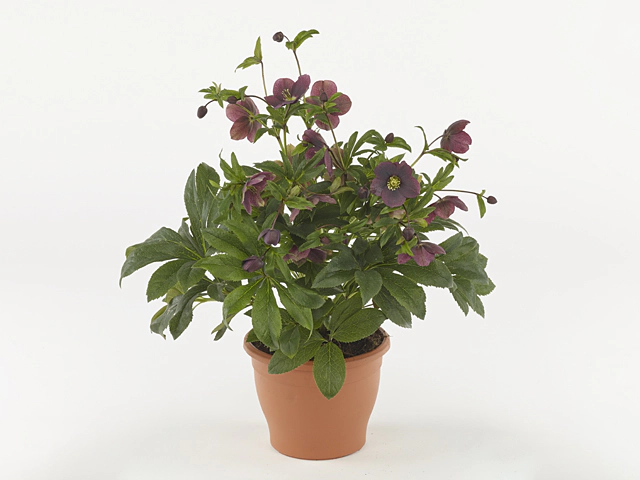Helleborus x hybridus Viv Victoria

| Flower type | Single |
| Leaf margin | Serrate |
| Winter hardness | Good (USDA-zone 5, 6); Excellent (USDA-zone 1,2,3,4) |
| Flower color | Purple-dark purple-N077B |
| Flower diameter | 6,5 - 7 cm |
| Plant height | 30 - 40 cm |
| Flowering month(s) | September; October; November; December |
| Leaf size | 15 - 20 cm |
| soil pH requirement | Alkaline (pH > 7,5); Slightly acidic (pH 4,5 - 6,5); Neutral (pH 6,5 - 7,5) |
| Light conditions | Semi-shades |
| Leaf division | Palmate |
| Leaf, main color | Dark green |
| Leaf colour, pattern | Unicolored |
| Flower color distribution | Veined; Multi-colored; With trace |
| Flower, secondary color(s) | Black-black-N187A; Purple-dark brown-N077A; Pink-dark blue pink-186C |
| Toxicity (if consumed) | Toxic |
| Moisture requirements | Well-drained; Moist |
| Soil type | Humus rich |
Helleborus x hybridus Viv Victoria, also known as Hellebore, is a stunning flowering plant with a range of impressive characteristics. This article will delve into the various aspects of this plant and provide valuable information for gardening enthusiasts.
One of the first features to note about Helleborus x hybridus Viv Victoria is its single flower type. Each flower possesses a striking purple-dark purple color, with a diameter ranging from 6.5 to 7 cm. This medium-sized flower adds a touch of elegance to any garden.
In terms of its winter hardiness, Helleborus x hybridus Viv Victoria performs exceptionally well. It is categorized as "Good" for USDA zone 5 and 6, but truly excels in USDA zones 1, 2, 3, and 4. This means that gardeners in colder climates can still enjoy the beauty of this plant throughout the winter season.
The plant itself grows to a height of 30-40 cm, making it suitable for both borders and containers. It flowers during the months of September, October, November, and December, providing a burst of color in the late autumn and early winter months.
The leaves of Helleborus x hybridus Viv Victoria are another noteworthy feature. They have a serrate leaf margin and palmate leaf division, giving them an attractive and distinctive appearance. The main color of the leaves is dark green, which beautifully complements the purple-dark purple flowers. The leaf size ranges from 15 to 20 cm, creating a balanced visual aesthetic.
When it comes to soil pH requirements, Helleborus x hybridus Viv Victoria is adaptable. It can thrive in alkaline soil with a pH above 7.5, slightly acidic soil with a pH between 4.5 and 6.5, as well as neutral soil with a pH ranging from 6.5 to 7.5. This versatility makes it a suitable choice for a wide range of garden settings.
In terms of lighting conditions, Helleborus x hybridus Viv Victoria prefers semi-shaded areas. It does well with partial sunlight, allowing gardeners to place it in areas where it can receive some shade during the day.
Additionally, this plant prefers well-drained and moist soil. It does best in humus-rich soil, which provides essential nutrients for healthy growth. By ensuring proper moisture requirements are met, gardeners can help Helleborus x hybridus Viv Victoria thrive and produce beautiful flowers.
Despite its beauty and versatility, it is essential to note that Helleborus x hybridus Viv Victoria is toxic if consumed. Therefore, caution should be exercised when planting it in gardens frequented by children or pets.
In conclusion, Helleborus x hybridus Viv Victoria is a remarkable plant with a range of attractive features. From its single purple-dark purple flowers to its palmate dark green leaves, this plant adds beauty and elegance to any garden setting. With its adaptability to different soil types and preferences for semi-shade and moist, well-drained soil, it is a versatile choice for gardening enthusiasts. Just remember to keep it out of reach from children and pets due to its toxicity.
Market availability index by month:
| Jan. | Feb. | Mar. | Apr. | May | Jun. | Jul. | Aug. | Sep. | Oct. | Nov. | Dec. |
|---|---|---|---|---|---|---|---|---|---|---|---|
| 3 | 3 | 2 | 1 | - | - | - | 1 | 2 | 3 | 4 | 2 |